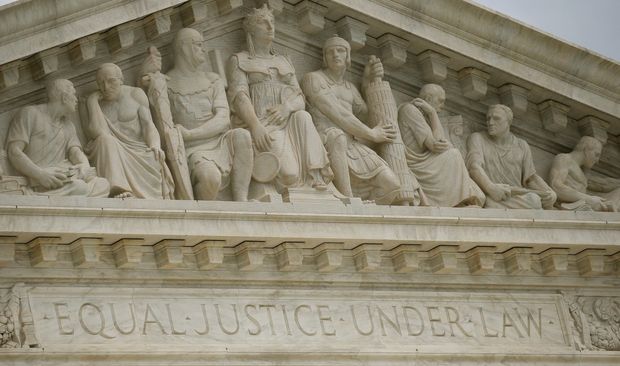
The epigraph on the front of the U.S. Supreme Court building reads “Equal Justice Under Law.”
Mark Wilson/Getty Images
CHICAGO (Project Syndicate)—Since Donald Trump’s election in 2016, legal academics like me have been bombarded with emails from journalists asking whether the United States is undergoing or heading for a “constitutional crisis.”
Most of these queries have been motivated by the president’s norm-busting, including his interference with Special Counsel Robert Mueller’s investigation of Russian interference in the election, his verbal attacks on journalists and judges, and his efforts to launch investigations against his political opponents.
“ This crisis would arise from a tension that has existed throughout American history: namely, between the courts and a system of democracy that gives ultimate power to the people. ”
A constitutional crisis, properly understood as a turning point that might lead to collapse or transformation of the system, has not occurred. But such a crisis does now appear increasingly likely.
I am not talking about the election (though that could produce a constitutional crisis if the outcome is close, or in the unlikely event that Trump somehow refuses to leave office). Rather, I am referring to a crisis that could occur even if Trump loses. This crisis would arise from a tension that has existed throughout American history: namely, between the courts and a system of democracy that gives ultimate power to the people.
The Civil War, and the New Deal
There have been two constitutional crises in American history. Both of them involved a clash between the Supreme Court and elected officials backed by popular opinion.
The first began with the infamous case of Dred Scott v. Sandford in 1857. In that case, the Supreme Court held that African-Americans were not citizens of the United States, and that the 1820 Missouri Compromise—which had staved off civil war by providing a formula for dividing territory between slave and free states—was unconstitutional.
The court’s ruling inflamed tensions between North and South, and contributed to the Civil War, in part by blocking a path to compromise. The ensuing constitutional crisis outlasted the war by more than a decade, as the court continued to undermine legislation and constitutional amendments meant to protect freed slaves, and as Congress retaliated by stripping the court of jurisdiction.
The ultimate resolution confirmed the abolition of slavery and the union of the states, but preserved an apartheid system in the South.
“ If the Supreme Court issues still more adverse rulings against the ACA, the future not just of the ACA but of any ambitious progressive legislation will be in doubt. ”
The second crisis took place in the 1930s, when the Supreme Court struck down New Deal statutes meant to address the economic emergency of the Great Depression. In 1937, fresh from an overwhelming electoral victory, President Franklin D. Roosevelt proposed legislation to pack the court with pro-New Deal jurists. Though the bill was defeated, the court backed down, reversing its opposition to economic regulation.
Even after Roosevelt was able to fill vacancies and secure a sympathetic majority, the court would remain gun-shy for another 20 years.
The coming crisis
Given today’s heightened political volatility, there is no knowing exactly what shape the next constitutional crisis will take; however, the broad contours are coming into view.
As in the previous contests, the right has captured the Supreme Court, but lost the battle for public opinion.
Since the 1980s, conservative rulings have increasingly constrained national economic regulations—echoing the once-discredited approach of the pre-1937 Court—and created an individual right to gun possession, strengthened religious rights, overturned restrictions on campaign financing, weakened protections for racial minorities, and eroded abortion rights.
On the left, unhappiness with the court has been simmering since the 1980s, but two developments have brought the anger to a boil in recent years.
First, the Affordable Care Act (Obamacare), the signature progressive accomplishment of the last 20 years, has been placed in grave danger. The law was barely upheld by the Supreme Court in 2012, and since then has been battered by a variety of legal challenges in the lower courts.
If the Supreme Court issues still more adverse rulings against the ACA, the future not just of the ACA but of any ambitious progressive legislation will be in doubt.
Related story: Supreme Court will weigh Trump plan to exclude undocumented immigrants from Census count
Second, Democrats no longer trust Republicans to play by the rules with respect to judicial appointments, owing to the GOP’s turnabout on Supreme Court nominations.
Having refused even to hold hearings for President Barack Obama’s Supreme Court nominee, Merrick Garland, in 2016, citing the approaching presidential election, the Senate’s Republican majority has now rushed through confirmation hearings for Trump’s nominee, Amy Coney Barrett, less than a month ahead of the next election.
Also read: Flowers, homemade signs, singing outside Supreme Court in tribute to Ruth Bader Ginsburg
This bad faith, along with bad luck in the timing of Supreme Court vacancies, all but ensures that there will be a conservative court majority capable of blocking Democratic legislation for at least the next four years—and probably much longer.
Biden’s dilemma
The combination of a right-wing Supreme Court and perceived Republican bad faith has emboldened Democrats to play their own form of hardball. Many on the left want Trump’s opponent, Joe Biden, to commit to “packing the court” if he is elected. That would mean increasing the number of seats—presumably from nine to 13—so that four more justices can be appointed to create a 7-6 majority friendlier to a liberal agenda.
The significance of this proposal is hard to exaggerate. Roosevelt’s court-packing plan went down to a devastating defeat and caused lasting political damage to his presidency.
Court-packing is a radical act, a favored tactic of despots.
And the Supreme Court remains relatively popular among the public. Nonetheless, Biden, despite his moderate instincts, has not been able to distance himself from the idea, no doubt worried about blowback from the left wing of the Democratic Party.
But Biden’s problem is not with the left; it is, or will be, with the court. After all, his campaign has increasingly focused on promising health care and a stronger response to the pandemic—two areas where conservative judges have shown great hostility.
Thus, if Biden wins the election and obtains a majority in both houses—which he will need in order to implement any court-packing plan—he will face a dilemma.
If he tries to pack the court, he runs the risk of losing the support of moderate Democrats, deepening political polarization, and damaging the court’s standing in the eyes of the public. But if he does not, he may be rendered politically impotent.
Even Roosevelt was too embarrassed to call his bill a court-packing plan. Instead, he claimed that the aging judges throughout the federal judiciary needed to be supplemented by a younger cohort.
Biden, nowhere near as popular as Roosevelt was, has no good options but to hope that the conservative justices on the court show good sense and moderate their hostility to popular legislation and government action.
Chief Justice John Roberts has hitherto demonstrated that this is possible. But with the addition of Barrett to the court, Roberts could find himself in the minority. And if Barrett joins the other four hard-line conservatives in overruling the will of a democratically elected government, the ensuing constitutional crisis could take years to resolve.
Eric Posner, a professor at the University of Chicago, is the author, most recently, of “The Demagogue’s Playbook: The Battle for American Democracy from the Founders to Trump” (All Points Books, 2020).
This article was published with permission of Project Syndicate—Is the Long-Awaited Constitutional Crisis at Hand?
Suggested reading
Paul Brandus: We aren’t just electing a president; we’re electing the next Supreme Court
From Barron’s: Supreme Court Chaos Is a Symptom of America’s Institutional Decay
Opinion from The Conversation: Here’s how the Supreme Court can protect its reputation amid political partisanship








